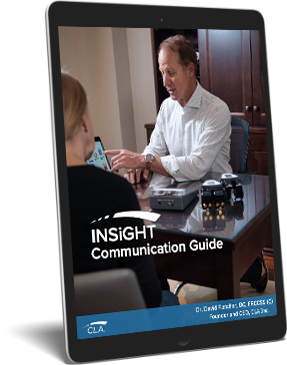At CLA we make a lot of word connections.
I love to talk about the 3 Essential D’s: Dysafferentation, Dysponesis and Dysautonomia. I love to connect how these concepts relate to scanning the nervous system with the INSiGHT. In this Blog I am going to answer the question:
“How can I make collecting scan data meaningful to my patients?”.
Again, the answer is that it’s easier than you might imagine! Simply put: let us do the heavy lifting for you. CLA has been the thought leader in neurofunctional assessments and reporting for over thirty years. In that time, we have learned what the data means on a research and clinical basis, and we also have been dedicated to streamlining the reporting of all that data.
To begin, we use the data to create scan views that allow instant recognition of the otherwise invisible patterns of neurofunctional activity. Patterns, in three clarifying colors, highlight the intensity of change occurring deep within the nervous system. These images can be arranged and presented in an unlimited number of layouts and now, with our most up to date software, Synapse, the sharing of these scan views and reports can be done digitally and effortlessly. Printing reports can become a thing of the past when you have the ability to AirDrop, email and project the scans from an iPad.
That’s all fine and exciting but we have also taken the step forward by engaging data scientists and clinical experts to review hundreds of thousands of scans contained in our data repository. We asked them to create efficiency scores for each scan that is performed. That means that not only can you show images of the nervous system function but now you can share their neurofunctional efficiency score, the CORESCORE, making reporting results faster and consistent.
CLA took one more step when working on score calculations.
It’s fabulous to get a thermal scan and see distinctive patterns that affect the control of the organs and glands. It’s amazing to understand a patient’s adaptive reserve by watching where their HRV plots and to observe the amount of neuromuscular energy needed to manage postures as seen through the lens of EMG scans. These individual scores are powerful indicators of the need to remain not only well-adjusted but what would it means to have all three data sets combined?
We asked our data team and doctors what would make their lives even easier, and they all said, create one powerful scoring model that we can report from and that patients could use to track their progress. From that, the CORESCORE was born! We were able to take the scores from all three instruments and create an algorithm that blended the data and delivered a single number score that represented the neurological efficiency of each patient’s nervous system.
This index is presented as a percentile and so it allows each patient to understand how important function is regardless how they feel. They can strive to work towards a higher CORESCORE knowing you are their “neurological programmer” and wellness guide in all aspects of their care. They understand that a higher score means more vitality and more stability in their health. Patients are empowered to raise their score rather than focus on their symptoms. They know from their school report cards that an 80 is an A and that a 60 is a C. Now they have their own personalized neurological report card as a reference!
Harnessing the power of our Synapse software allows for the four sequence CORESCORE reporting system takes over! Using the patient’s scan data, a specific report is built describing their results on the Initial, Progress, Comparative and ongoing Continuation exams. Scanning and reporting is no longer a challenge for the doctor and it’s inspiring for the patient!
As you can see, CLA has invested its time and resources to create a science-based approach that is easily integrated into any sized office. ‘The Destructive D’s’ blogs opened this conversation about the importance of scanning the nervous system. By focusing on two excellent questions we’ve been able to share the practical side of utilizing the power of the INSiGHT. In our next blog we will dive into another question!
Chat with our team to get started today, or click here to take our Practice Blocker Quiz to find out if scanning is right for you.

























































































































































